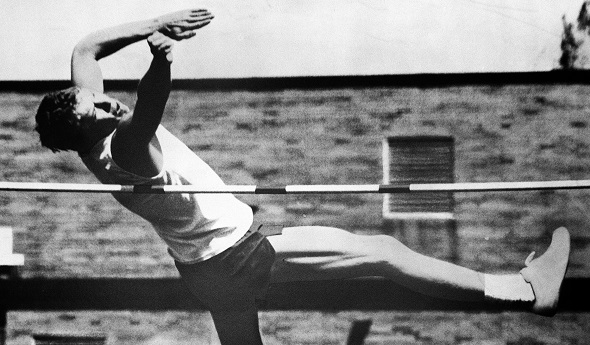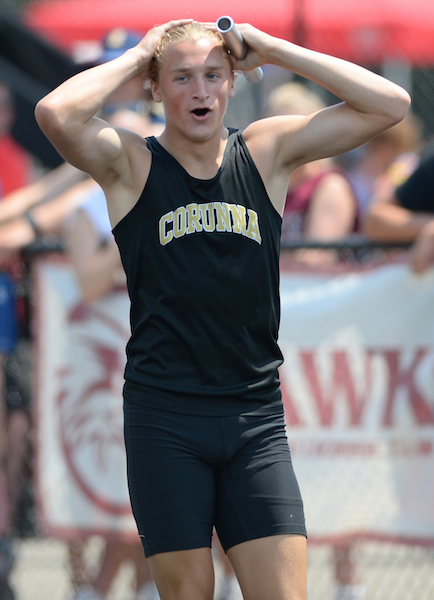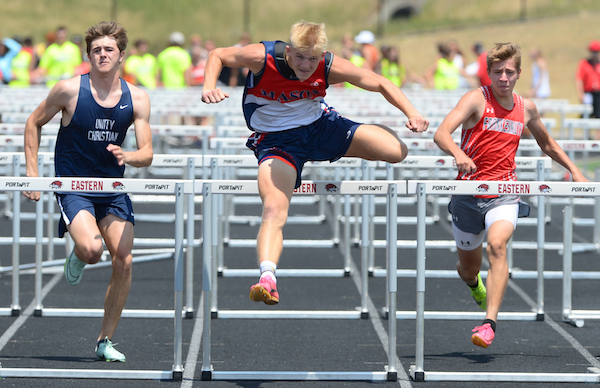
Brimley Jumper's Leap Soars On as Finals Best
June 6, 2019
By Dennis Grall
Special for Second Half
BRIMLEY – Thirty years ago this spring, John Payment became an unlikely part of Michigan high school track & field history.
 In some respects, it almost seems like yesterday the Brimley High School senior soared 7-feet, 1 inch, to set an MHSAA Finals high jump record that still stands. In fact, Payment is the only Upper Peninsula athlete in this sport to own an all-Finals record – meaning his performance remains the best all-time from any class or division in either peninsula.
In some respects, it almost seems like yesterday the Brimley High School senior soared 7-feet, 1 inch, to set an MHSAA Finals high jump record that still stands. In fact, Payment is the only Upper Peninsula athlete in this sport to own an all-Finals record – meaning his performance remains the best all-time from any class or division in either peninsula.
Payment is still approached by strangers about his performance that 1989 day in Marquette, and is stunned people remember what he did.
Think about it: A high school senior with a minimal high jump history from a tiny Upper Peninsula town accomplished a feat that has not been duplicated by hundreds of athletes from big cities like Detroit, Flint and Grand Rapids.
It is mind-boggling it happened, and mind-boggling the record still stands. Talk about doing something very notable well beneath any radar screen.
"It is kind of neat to say no one in the state of Michigan has ever done this," Payment said in a telephone interview on the eve of the 2019 Upper Peninsula Track & Field Finals. "It is actually kind of weird to say it.
"It is very humbling. It is amazing people haven't forgotten. It never gets old."
Payment still finds it hard to believe it happened. He had never been able to break the 6-10 barrier in a meet, even though practice jumps convinced him he could surpass that mark.
At the U.P. Finals, he even passed until the bar got to 6-11. He missed twice at 7-0, then easily cleared it on his final try, by a couple of inches. He then asked officials to put the bar at 7-1, but his next jump was delayed until the height could be measured officially to ratify the record attempt.
By that time, the public address announcer had explained Payment’s opportunity to the huge crowd in attendance at what remains the Upper Peninsula's largest one-day prep athletic contest. The meet basically came to a stand-still as athletes in the infield gathered around the high jump bar.
"(The official) stood on a folding chair and measured the bar at 7-1," said Payment. "He then told me, 'Son, if you do this, it is a state record.'"
After clearing that record-setting height, Payment said, "I was excited. Then I tried 7-2, but my legs got rubbery and I just couldn't do it. They said I cleared 7-1 by 3-4 inches. I just couldn't do it anymore. I had an adrenalin rush, but I just wore out."
Obviously very excited at what had just happened, the request to go at 7-2 came up instantly – and he never really had a chance to collect his thoughts and rejoice.
"I couldn't wait for the other jumpers to jump because they were done. It was like boom, boom, boom. I couldn't just sit down and let it sink in," he recalled.
In the immediate aftermath, Payment said he understood what had just happened. "It was huge; it was like a sigh of relief that I just did 7-feet. I was more in awe than anything. (But) I didn't get a chance to savor it."
The realization of what he did hit home on the way back to Brimley when he learned the Detroit Free Press was trying to contact him for an interview. "It was like, wow, this is something. Now it is a bigger deal. It took a little while to have it soak in about the caliber of the jump," he said.
Payment and teammates Bob Carrick and Kevin Sutton finished 1-2-3 in the high jump in U.P. Class D that day, and Payment said having good teammates and their competition helped him reach record heights. In fact, Carrick helped him adjust his approach by having Payment start a step closer on the blacktop rather than begin on the grass.
"I had three teammates always helping. We would be laughing and joking. It wasn't stressful. That was helpful. It was an individual event, but we made it our individual event," he said.
He also adjusted from a J approach to a straight-on Fosbury Flop to clear the bar.
Blessed with strong legs, Payment said he "messed around in the gym" and then his coach, John Morrison, said he should try the event. "I cleared it pretty good," said Payment.
As a junior, he drove to Mount Pleasant and worked with the Central Michigan University coach, who later came to Brimley for some on-site coaching. "We just jumped. It was fun," he said, indicating he quickly was clearing 6-8 but the mental block struck at 6-10. "I couldn't get past it," he said, even though he was sure he could clear that barrier.
He is still shocked at the response of athletes and fans who focused on his state record effort. "High jump is not a flashy sport, it is not the main (track & field) attraction," he said.
"It was definitely exciting (that day). Once I cleared seven feet, people went crazy. Believe it or not, but I just focused on doing it. I don't think I noticed the crowd until afterward. People shook my hand and asked for autographs. It was really something."
The accomplishment opened a whole new world to the innocent youngster. He competed in all-star track invitationals in Indiana and Chicago against athletes from across the country, quite a leap for someone from the shores of Gitchee Gumee just south of the Canadian border. In fact, he flew to Chicago, which was his first airplane ride.
His part of the world was so small, but suddenly it had enlarged well beyond his imagination.
College track coaches and recruiters were now after the unsung champion, who was somewhat uncomfortable being the talk of the town.
He turned down the chance to attend college and compete at the higher levels of high jump. "The opportunities were there, but for me it just wasn't my thing," he conceded, indicating it became more important to get a job and start earning money.
"It was a real eye-opener. You don't realize what is all out there, and to leave a small town and see what was out there," he said, adding more classroom work was not a priority.
"The schooling I wanted to be done with," he said, noting his parents encouraged him to attend college. "Maybe I was just scared. My grades were not the best. Life goes on, the what-ifs go on."
Payment, who also played football (wide receiver), basketball and baseball at 6-3, 175 pounds, for the Bays simply decided to move on with his life. He got a job with the road commission and still works there, although he now weighs about 275.
"The world is full of what-ifs. I've got some regret I didn't go on and try, but we've got four kids and four grandkids and another one on the way. I'm doing all right," he said.
 Denny Grall retired in 2012 after 39 years at the Escanaba Daily Press and four at the Green Bay Press-Gazette, plus 15 months for WLST radio in Escanaba; he served as the Daily Press sports editor from 1970-80 and again from 1984-2012 and currently is in a second stint as the interim in that position. Grall was inducted into the Upper Peninsula Sports Hall of Fame in 2002 and serves as its executive secretary. E-mail him at [email protected] with story ideas for the Upper Peninsula.
Denny Grall retired in 2012 after 39 years at the Escanaba Daily Press and four at the Green Bay Press-Gazette, plus 15 months for WLST radio in Escanaba; he served as the Daily Press sports editor from 1970-80 and again from 1984-2012 and currently is in a second stint as the interim in that position. Grall was inducted into the Upper Peninsula Sports Hall of Fame in 2002 and serves as its executive secretary. E-mail him at [email protected] with story ideas for the Upper Peninsula.
PHOTO: Brimley's John Payment flies over the high jump bar in 1989 to set an all-MHSAA Finals record in the event that still stands. (MHSAA file photo)

Vicksburg's Wright, Corunna Right On in Claiming LPD2 Championships
By
Steve Vedder
Special for MHSAA.com
June 3, 2023
ADA – If Michael Wright was a baseball player, he probably would've been called out on strikes a year ago.
Instead, the Vicksburg senior can celebrate after winning the 200 at Saturday's Lower Peninsula Division 2 Track & Field Finals at Forest Hills Eastern.
The road to the championship in the 200, via a time of 21.72, was anything but a straight line for Wright. An aspiring baseball player, he was cut from the Vicksburg squad as a freshman. His football career, by Wright's own admission, was "on and off." And then a year ago in his first track meet, Wright suffered a leg injury that virtually ended his season. He did return to finish fifth in the 200 at Finals while helping the 400 relay team to a 16th place.
So there is nothing to realistically explain how Wright found himself in the position Saturday at sweltering Forest Hills Eastern to win a championship. Except for returning this season to break the school record in the 200 four times in two months. Well, that and willpower and simple desire.
 "I knew I could finish high, maybe in the top five. But this is better," said Wright, who credits drinking large quantities of milk for his resurgence. "I looked to football because I didn't think I could bounce back for track. But I overcame the bumps, the obstacles."
"I knew I could finish high, maybe in the top five. But this is better," said Wright, who credits drinking large quantities of milk for his resurgence. "I looked to football because I didn't think I could bounce back for track. But I overcame the bumps, the obstacles."
While Wright was jump-starting his track career, Corunna won the team title with 41 points. Mason and Forest Hills Eastern tied for second with 35. Whitehall was fourth with 33 points, and Frankenmuth fifth with 29 points.
Corunna coach Jeff Sawyer, who had never won a Finals title in 37 years coaching at Owosso and three more at Corunna, said the championship came after little fanfare during the season. Virtually right up until the time Corunna hauled off its first-place trophy, Sawyer said it was never really on his team's mind. The title came after the team managed only a runner-up finish at the Regional.
"We kind of low-keyed it," he said. "We knew scoring 40 points was possible. We lost to Frankenmuth by one point at the Regional. … We were a little disappointed we didn't win, but we had some good times today. We knew it was possible.
"Every day we just come and do what we do. We talk about getting better every day with PRs (personal records). And we're still getting better because we have some tough guys. Just competitive, tough kids. But we were the underdogs."
Corunna had only two firsts on Saturday, in the 400 relay (42.63) and Wyatt Bower in the long jump (22-8½).
Among the individual highlights was Frankenmuth senior Dalton DeBeau, who successfully defended his Finals title in the discus (171-6). He was fifth in that event as a sophomore and after winning a year ago, was considered a good bet to repeat.
"I kind of expected it," said DeBeau, who will compete at Michigan State next spring. "There wasn't a lot of pressure. I knew what had to be done. I threw 160 feet on my first throw to get in the finals, and that helped right away. I knew I could go all out."
 Berrien Springs' Jake Machiniak won the 100 (10.54) while the team also captured the 800 relay (1:28.18). Machiniak said his season hasn't been without its share of difficulties. There was a time when he couldn't seem to come out of the starting blocks smoothly. But beginning with the conference meet where he ran school record 10:73, Machiniak felt himself back on course.
Berrien Springs' Jake Machiniak won the 100 (10.54) while the team also captured the 800 relay (1:28.18). Machiniak said his season hasn't been without its share of difficulties. There was a time when he couldn't seem to come out of the starting blocks smoothly. But beginning with the conference meet where he ran school record 10:73, Machiniak felt himself back on course.
"There were ups and downs. I struggled in the middle of the season," he said. "But my teammates helped me through some difficulties. I came here to finish the job; I knew I could do something here."
Mason's Tyler Baker won the 100 hurdles (14.63) to complete a long journey that included finishing just ninth in last year's prelims. The success was as simple as putting in loads of offseason work.
"I practiced and did stuff about every day," he said. "I might not be the fastest, but I make up for that in form. It's a fine-tuning thing. Everyone wants to be faster."
Mason also got a championship from A.J. Mantel, who captured the 300 hurdles (38.90).
Among other highlights was Forest Hills Eastern senior Aiden Sullivan successfully defending a 2022 title on his own home turf. He won Saturday's 800 (1:53.92).
Adrian won the 3,200 relay (7:39.77), while Grand Rapids Christian took the 1,600 (3:24.49).
Alma had two individual winners in Michael Howey in the shot (55-08) and Jacob Dunlap in the high jump (6-7).
The other champs were Kyle Eberhard of Linden in the 1,600 (4:14.79), Whitehall's Trannon Ayler in the 400 (48.83), Freeland's T.J. Hansen in the 3,200 (9:11.56) and Sam Vesperman of Grosse Ile in the pole vault (15.01). Chelsea senior Jacob Nelson competed in the adaptive 100 (27.28), 200 (57.71) and shot put (6-6).
PHOTOS (Top) Vicksburg's Michael Wright celebrates after winning the 200 on Saturday. (Middle) Corunna's Tarick Bower enjoys a moment after anchoring the winning 400 relay. (Below) Mason's Tyler Baker, center, works to stay ahead in the 110 hurdles. (Photos by Dave McCauley/RunMichigan.com.)

